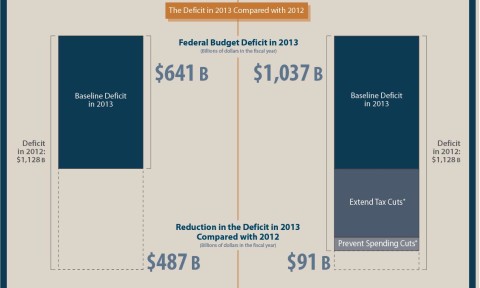What Is The Fiscal Cliff?
The end of the year is around the corner and every news organization is spreading the alarm as the ominous sounding fiscal cliff nears. Unfortunately, the explanations about the fiscal cliff provided by most news organizations are unsatisfactory and instead of clearing up confusion they simply cause more of it.
So my intention with today’s article is to define what the fiscal cliff exactly is. Monday’s article will clarify the finer points about how the fiscal cliff may affect your investments and retirement.
The Congressional Budget Office offers us insight into the fiscal cliff with a lovely infographic that can be found in full here. I’ll break it down piece by piece throughout today’s article.
Where Are We Now?
Under current law, there will be an expiration of numerous Bush Era Tax cuts for individuals and businesses, which will cause higher taxes for the middle and upper classes. The payroll tax cuts of 2012 will expire, the alternative minimum tax (AMT) limits will revert back to year 2000 values, affecting more of the middle class, and small spending cuts will take place. All of these factors will work together to lower the budget deficit in 2013.
On the right in the picture below, we have the projected budget deficit if Congress chooses to extend current tax rates and prevent the spending cuts that are set to occur at the beginning of the year.
On the left in the picture below, if Congress elects not to change any of the current laws, the budget deficit will be lowered from the scenario on the right by $487 billion. The scenario on the left is known as the baseline.

If the current tax rates and spending levels are maintained, government debt will rise to 90% of GDP by the end of 2022. If baseline changes are elected, deficits will likely be reduced from 73% of GDP in 2012 to 58% in 2022.

These two scenarios are both extreme examples and therefore we can expect the final decision to fall somewhere in between the two. But let’s continue looking at the CBO’s infographic.

Under the baseline scenario, the tax increases will likely cause a short recession during 2013 and an increase in unemployment to from the current 7.9% to 9.1%. Under the tax extension scenario, we can expect the economy to grow during 2013 and unemployment rate to stay around the same.
What’s Next?
The budget of the last decade has left us with unsustainable spending and an ever increasing portion of our budget has been spent on debt service. The current revenue and spending levels will cause dramatic long term harm to our economy if they are maintained. It will be interesting to see how Congress attempts to balance spending cuts and tax increases so as not to send the economy into a lasting recession.
Sources:
Economic Effects of Reducing the Fiscal Restraint That Is Scheduled to Occur in 2013

